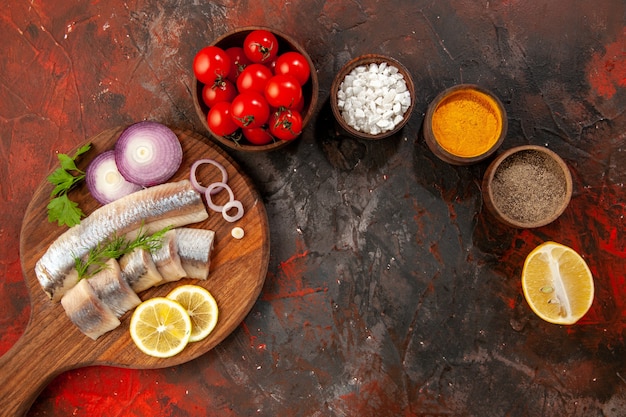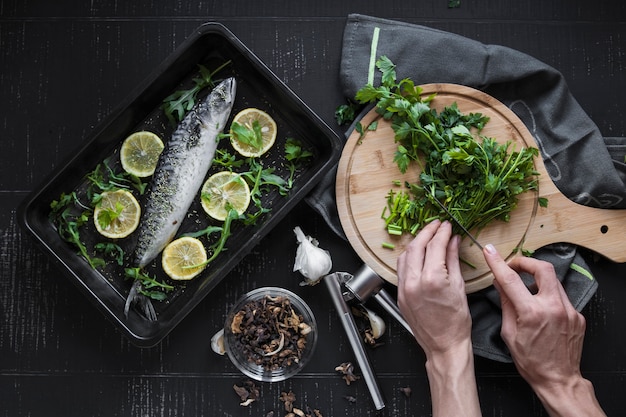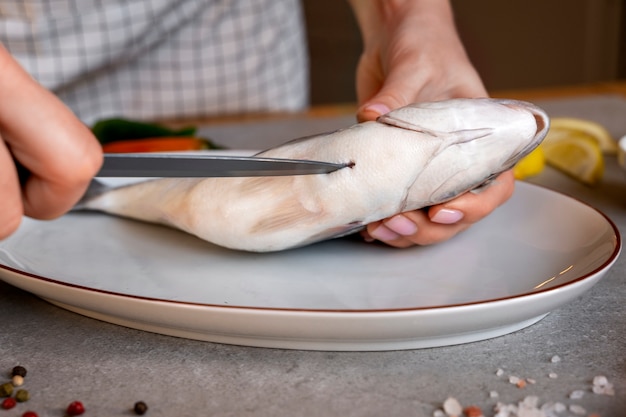(Part 1) The Importance of Temperature

I vividly remember the day I served my family a pan of sea bass that looked absolutely perfect. It was firm to the touch, flaked beautifully, and smelled divine. But the moment I took a bite, I knew something was off. It was just a touch undercooked, and I can still feel that shiver of unease. From that day forward, I vowed never to take such a risk again. That's when I embraced the humble food thermometer! It's a small investment that guarantees your fish is cooked through and through.
Why Temperature Matters
Here's the deal: cooking fish to the right temperature is crucial for a few key reasons:
- Safety First: It's all about avoiding those nasty foodborne illnesses. Undercooked fish can harbor harmful bacteria that could make you very sick.
- Texture Magic: When cooked to the perfect temperature, fish is a dream - tender, flaky, and melts in your mouth. Overcooked fish, however, turns dry and tough, a real let-down.
- Flavor Explosion: Cooking fish to its ideal temperature allows its natural flavors to truly shine. It's a game-changer!
The Danger Zone: A Fishy No-Go Area
You've probably heard about the "danger zone" in food safety. Well, for fish, it's between 40°F (4°C) and 140°F (60°C). That's the temperature range where bacteria love to party. So, you want to avoid letting your fish hang out in that zone for too long. Cook it immediately or keep it chilled in the refrigerator until you're ready to cook.
(Part 2) Choosing the Right Thermometer: Your Fishy Ally

Don't stress about needing a fancy, top-of-the-line thermometer. You can find a fantastic one for a reasonable price at most supermarkets or online. Personally, I use a simple digital thermometer with a probe. It's super easy to use and gives me accurate readings within seconds.
Types of Thermometers: Finding the Perfect Fit
Let's break down the main types of thermometers so you can choose the one that suits you best:
- Digital Thermometers: My Personal Favorite: They're fast, accurate, and easy to read. Just insert the probe into the thickest part of the fish and you're golden.
- Infrared Thermometers: The Contact-Free Option: These measure temperature without touching the fish. Simply point it at the surface, and it will give you a reading. They're super convenient, but might not be as accurate as digital thermometers.
- Instant-Read Thermometers: For Smaller Fish: These are great for checking the temperature of smaller pieces of fish. They're also more affordable than digital thermometers.
(Part 3) The Perfect Temperature for Different Types of Fish: A Culinary Compass

This is where things get exciting! Every type of fish has its own ideal cooking temperature. It's all about finding that sweet spot where the fish is cooked through but still retains its moisture and delicious flavor.
A Quick Guide to Fish Temperatures:
| Fish Type | internal temperature (°F) |
|---|---|
| Salmon | 125-130 |
| Tuna | 130-140 |
| Cod | 140-145 |
| Swordfish | 145-150 |
| Shrimp | 145 |
| Scallops | 135-140 |
Remember: A Little Flexibility is Key
These are just guidelines. If you're cooking a thick piece of fish, it might take a few extra minutes to reach the desired temperature. And don't forget to check the fish's texture. It should be firm and flake easily.
(Part 4) Cooking Fish to the Right Temperature: Techniques for Success
Alright, you've got your thermometer, you know the ideal temperature for your fish, now let's talk about actually cooking it. I find these methods are consistently fantastic for cooking fish:
Baking: Simple and Reliable
Baking is a simple and reliable way to cook fish. Preheat your oven to 375°F (190°C), place the fish on a baking sheet, and bake for about 15-20 minutes. Just use your trusty thermometer to check the temperature and ensure it's cooked through.
Pan-Frying: Crispy Perfection
This method is perfect for creating a gloriously crispy crust. Heat a pan over medium heat, add a little oil, and carefully place the fish in the pan. Cook for about 3-5 minutes per side, or until the internal temperature reaches the desired level.
Grilling: Smoky Flavor Delight
Grilling adds a smoky flavor that's irresistible. Preheat your grill to medium heat, brush the fish with a little oil, and grill for about 5-7 minutes per side. Remember, always check the temperature!
Poaching: Gentle and Delicious
Poaching is a gentle way to cook fish, leaving it tender and moist. Bring a pot of water to a simmer, add some aromatic ingredients like onions, garlic, and herbs, and gently poach the fish for about 5-10 minutes, or until cooked through.
Steaming: Preserving Natural Flavors
Steaming is another gentle method that preserves the fish's natural flavors. Place the fish in a steamer basket and steam over simmering water for about 5-10 minutes, or until cooked through.
(Part 5) Signs of Overcooked Fish: A Culinary Warning System
We've covered cooking fish to the right temperature, but what about avoiding overcooking it? It's a common mistake, especially if you're not paying close attention. Here are some signs that your fish might be overcooked:
Texture: A Telltale Sign
The texture of overcooked fish is usually dry and flaky, lacking the delicate texture you desire. If it flakes apart easily and feels rubbery, it's likely overcooked.
Color: A Visual Cue
Overcooked fish can turn a grayish-white color, losing its natural shine and appearing dull.
Smell: The Nose Knows
Overcooked fish can have a slightly fishy smell, unlike the pleasant aroma of fresh fish.
Taste: A Disappointing Experience
Overcooked fish can taste dry and bland, losing its delicate flavor.
(Part 6) How to Fix Overcooked Fish: A Culinary Rescue Mission
Oops! You've overcooked your fish. Don't despair, it's not the end of the world. There are a few things you can do to salvage it:
Adding Moisture: Rehydrating the Fish
Overcooked fish is often dry, so you need to add some moisture back. You can do this by:
- Adding sauce: A creamy sauce can help to mask the dryness and add some flavor.
- Using lemon juice: A squeeze of lemon juice can brighten the flavor and add a refreshing touch.
- Adding herbs: Herbs like dill, parsley, and chives can add a burst of freshness.
Transforming the Fish: A Culinary Makeover
If the fish is really dry and tough, you might want to consider turning it into something else:
- Fish cakes: These are a fantastic way to use up leftover fish. Add mashed potatoes, herbs, and spices for a flavor boost.
- Fish soup: Soup is a great way to disguise dry fish. Add some vegetables, broth, and spices for a delicious meal.
- Fish dip: This is a great appetizer. Add cream cheese, sour cream, and herbs to the fish for a delicious spread.
(Part 7) Tips for Cooking Fish: Mastering the Art
Now that you've got the basics down, here are some extra tips to elevate your fish-cooking game:
- Don't Overcook It: The key to perfectly cooked fish is to cook it just until it's done. Overcooking will make it dry and tough.
- Choose the Right Cooking Method: Select a cooking method that's appropriate for the type of fish you're cooking.
- Season It Well: A simple sprinkle of salt and pepper can go a long way. You can also experiment with different herbs and spices.
- Rest the Fish: Let the fish rest for a few minutes after cooking. This allows the juices to redistribute, resulting in a more tender and flavorful fish.
(Part 8) Delicious Fish Recipes: Culinary Inspiration
Ready to put your new fish-cooking skills to the test? Here are a couple of my favorite recipes that I always turn to:
Grilled salmon with lemon and Herbs: A Classic Delight
Ingredients:
- 1 pound salmon fillet
- 1 tablespoon olive oil
- 1 lemon, thinly sliced
- 1 tablespoon fresh herbs (dill, parsley, thyme)
- Salt and pepper to taste
Instructions:
- Preheat grill to medium heat.
- Brush salmon with olive oil and season with salt and pepper.
- Place salmon on the grill and cook for about 5-7 minutes per side, or until cooked through.
- Top with lemon slices and herbs.
- Serve immediately.
baked cod with Garlic and Parmesan: Simple and Flavorful
Ingredients:
- 1 pound cod fillet
- 2 tablespoons olive oil
- 2 cloves garlic, minced
- 1/2 cup grated Parmesan cheese
- Salt and pepper to taste
Instructions:
- Preheat oven to 375°F (190°C).
- Place cod fillet on a baking sheet lined with parchment paper.
- Drizzle with olive oil and season with salt and pepper.
- Top with garlic and Parmesan cheese.
- Bake for about 15-20 minutes, or until cooked through.
- Serve immediately.
(Part 9) FAQs: Your Fish-Cooking Questions Answered
1. Can I use a thermometer to check the temperature of other types of food?
Absolutely! A food thermometer is a versatile tool that can be used to check the temperature of all sorts of things, like poultry, meat, and even baked goods.
2. How long should I cook a piece of fish?
The cooking time for fish will vary depending on the thickness of the fish, the cooking method, and the type of fish. It's always best to check the internal temperature with a thermometer to ensure it's cooked through.
3. What are some signs that fish is undercooked?
If the fish is still translucent, jiggly, or raw-looking in the center, it's probably undercooked. It's best to cook it a bit longer to ensure safety.
4. What if I don't have a thermometer?
If you don't have a thermometer, you can use other clues to tell if your fish is cooked through. The flesh should be opaque and flake easily with a fork.
5. Can I freeze fish after I've cooked it?
Yes, you can freeze cooked fish for up to 3 months. To freeze, wrap the fish tightly in plastic wrap or aluminum foil and place it in a freezer-safe container or bag.
Everyone is watching

Perfect Rice Every Time: The Ultimate Guide to Cooking Rice
Cooking TipsAs a self-proclaimed foodie, I've always been a bit obsessed with rice. It's the foundation of countless cuisi...

The Ultimate Guide to Cooking Asparagus: Tips, Techniques, and Recipes
Cooking TipsAsparagus. The mere mention of this spring delicacy conjures up images of vibrant green spears, crisp and burs...

Ultimate Guide to Cooking the Perfect Thanksgiving Turkey
Cooking TipsThanksgiving. Just the word conjures up images of overflowing tables laden with delicious food, the scent of r...

Prime Rib Roast Cooking Time Chart: Per Pound Guide
Cooking TipsPrime rib roast. Just the name conjures images of lavish dinners, crackling fires, and hearty laughter. It’s ...

Can You Cook Spaghetti with Gasoline? (The Shocking Truth)
Cooking TipsWe've all seen those crazy internet trends. You know, the ones that make you wonder, "Did someone actually try...
